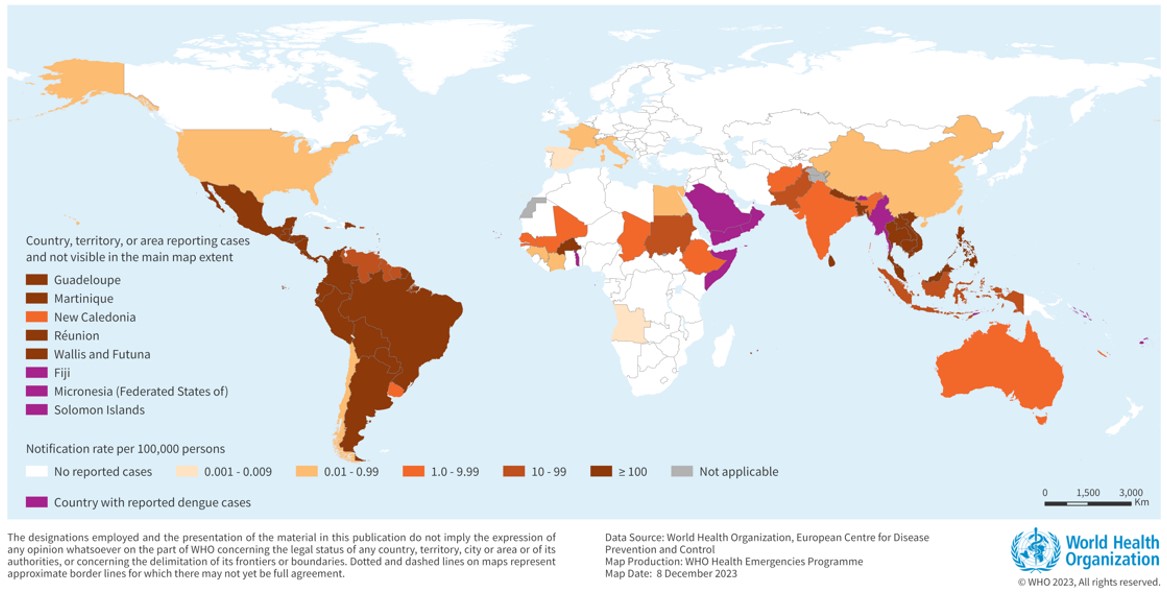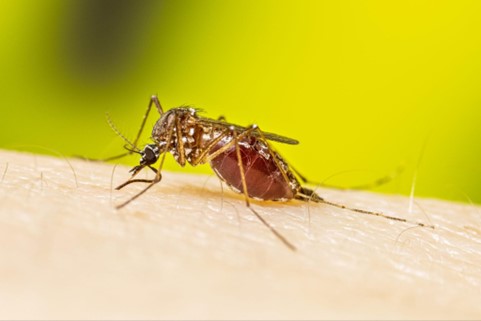Around the world, health authorities and governments are sounding the alarm as dengue fever spreads at an unprecedented rate. At least five million cases have been recorded globally by early December 2023 according to the World Health Organization, with the western hemisphere, in particular, facing an incredibly dire situation. A wave of dengue epidemics has rippled through several Caribbean island nations since August, while countries such as Brazil, Mexico, and Colombia met an unprecedented burden on their healthcare systems, with reports of shortages in medical supplies and personnel. In June, Peru declared a state of emergency in some parts of the country due to an insurmountable rise in infections and mortalities. Experts are pointing at a common culprit driving this sharp rise in cases: rising global temperatures. 2023 was the hottest year on record, per the National Oceanic and Atmospheric Administration.
Dengue fever, usually limited to warmer, tropical climates, has recently skyrocketed in nations where it has long been considered endemic. For instance, the South Asian country of Bangladesh experienced its worst dengue outbreak in history in November, which experts have attributed to warmer temperatures and the resulting longer monsoon season. Cases of dengue fever have also sprung up in areas not commonly associated with the tropical disease, such as the United States and Europe. In late October, a Southern California resident became ill with dengue fever, marking it the Golden State's first locally transmitted case. In 2023, Spain, Italy, and France have reported at least 100 autochthonous dengue cases by the start of December.

Source: World Health Organization
The dengue virus, a member of the Flaviviridae family, is primarily transmitted to humans through the bite of infected female Aedes aegypti and Aedes albopictus mosquitoes. They contract the pathogen after biting a person already infected with the virus and serve as vectors of the disease throughout their lifespan. Increasing temperatures worldwide promote the evaporation of more water into the air, eventually leading to more substantial precipitation. The resulting heavy rainfalls create innumerable pockets of stagnant water that serve as fertile breeding environments for the Aedes mosquitoes. The heat itself has a direct impact on the development of these insects. First, the increased temperatures can influence the reproductive capacity of mosquitoes, promoting the hatching of eggs and even expediting larval growth, effectively shortening the time to maturity. Second, the heat can augment the virus' replication within the mosquitoes' bodies by truncating its incubation time, which allows these insects to infect new hosts more quickly, thereby promoting transmission. Symptoms of dengue fever usually manifest 4-10 days following a bite from an infected mosquito and include: high fever, headaches, arthralgias, myalgias, skin rashes, nausea, vomiting, and even some mild bleeding, which may escalate to potentially life-threatening bleeding complications in severe cases.

Adult female Aedes aegypti taking a blood meal
Although there is no immediate remedy to the ever-increasing temperatures, there are a few ways to mitigate the symptoms of dengue fever and prevent its spread. Currently, there are no specific antiviral medications for the treatment of dengue fever. Management mainly centers on supportive care to ameliorate symptoms and thwart potential complications. Sick patients are advised to stay hydrated, as severe dengue fever can lead to fluid loss and dehydration. Analgesics such as acetaminophen are ideal for fever and discomfort, while aspirin and nonsteroidal anti-inflammatory drugs are contraindicated due to dengue-related bleeding complications. Hospitalization may be required in severe cases for close observation and administration of intravenous fluids. Individuals, especially those who reside near high-risk areas like ponds, lakes, and marshes, should be encouraged to take preemptive measures to avoid mosquito bites as much as possible. This may include the use of insect repellants, long-sleeved clothing, and mosquito nets, especially in peak mosquito activity times. Finally, eliminating stagnant water is key in depriving the Aedes mosquitoes of potential hatching sites. It is therefore paramount to routinely change the water in any functioning vessel that holds water (e.g., flower vases, pet water bowls) and otherwise discard items that can collect standing water (e.g., old tires, plastic containers).